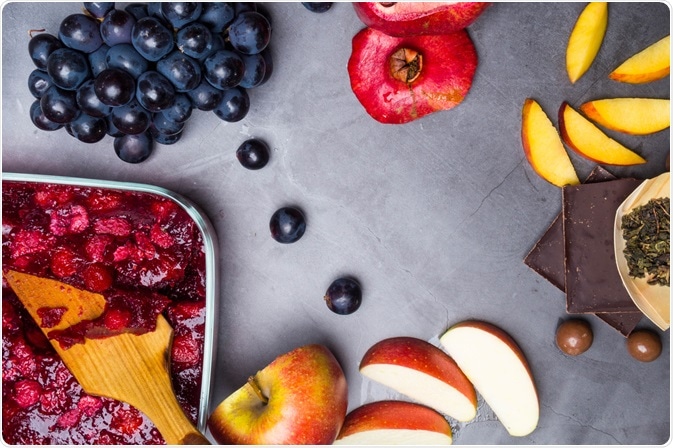Flavonoids are a group of plant metabolites thought to provide health benefits through cell signaling pathways and antioxidant effects. These molecules are found in a variety of fruits and vegetables.
Flavonoids are polyphenolic molecules containing 15 carbon atoms and are soluble in water. They consist of two benzene rings connected by a short three carbon chain. One of the carbons in this chain is connected to a carbon in one of the benzine rings, either through an oxygen bridge or directly, which gives a third middle ring. The flavonoids can be divided into six major subtypes, which include chalcones, flavones, isoflavonoids, flavanones, anthoxanthins and anthocyanins. Many of these molecules, particularly the anthoxanthins give rise to the yellow color of some petals, while anthocyanins are often responsible for the red color of buds and the purple-red color of autumn leaves.
Flavonoids are abundant in plants, in which they perform several functions. They are essential pigments for producing the colors needed to attract pollinating insects. In higher order plants, flavonoids are also required for UV filtration, nitrogen fixation, cell cycle inhibition, and as chemical messengers. Flavonoids secreted by a plant’s roots aid the symbiotic relationship between rhizobia and certain vegetables such as peas, clover and beans. The rhizobia present in soil produce Nod factors in response to the presence of flavonoids. These Nod factors are then recognized by the plant, which induces certain responses such as ion fluxes and root nodule formation. Some flavonoids also inhibit certain spores to protect against certain plant diseases. Flavonoids are ubiquitous in plants and are the most common type of polyphenolic compound found in the human diet.

Image Credit: Artemidovna / Shutterstock
The abundance of flavonoids coupled with their low toxicity relative to other plant compounds means they can be ingested in large quantities by animals, including humans. Examples of foods that are rich in flavonoids include onions, parsley, blueberries, bananas, dark chocolate and red wine.
Health benefits to humans
Flavonoids are important antioxidants and promote several health effects. Aside from antioxidant activity, these molecules provide the following beneficial effects:
- Anti-viral
- Anti-cancer
- Anti-inflammatory
- Anti-allergic
One flavonoid called quercetin can help to alleviate eczema, sinusitis, asthma, and hay fever. Some studies have shown that flavonoid intake is inversely related to heart disease, with these molecules inhibiting the oxidation of low-density lipoproteins and therefore reducing the risk of atherosclerosis developing.
Flavonoids are also abundant in red wine, which some have theorized is the reason why the incidence of heart disease may be lower among the French (who have a relatively high red wine intake) compared with other Europeans, despite a higher consumption of foods rich in cholesterol (French paradox). Many studies have also shown that one to two glasses of wine a day can help protect against heart disease.
Some types of tea are also rich in flavonoids and their consumption is thought to lower levels of triglycerides and cholesterol in the blood. Soy flavonoids or isoflavones also lower cholesterol, as well as protecting against osteoporosis and alleviating the symptoms of menopause.
The daily intake of dietary flavonoids typically ranges from anywhere between 50 and 500 mg, meaning the contribution to antioxidant activity varies widely between individuals.
Food sources
Almost all fruits, vegetables and herbs contain a certain amount of flavonoids. They can also be found in other food sources including dry beans, grains, red wine and green and black teas. The general rule is that the more colorful a food item is, the richer it will be in flavonoids. Oranges, however, are an exception to the rule because the flavonoids contained in this fruit are mainly found in the white and pulp interior of the skin.
The best way to ensure a good intake of flavonoids is to consume plenty of fresh fruit and vegetables on a daily basis. Experts advise eating five servings of vegetables and four of fruit. Regarding the intake of red wine, men are advised not to drink more than two glasses per day and women should not drink more than one glass per day.
Flavonoid supplements are also available, but people who buy these should note that experts have not confirmed what the ideal flavonoid intake is and an excess intake may even be harmful.
Interactions
Certain drugs do interact with flavonoids. Studies have shown that the enzyme cytochrome P450, which is involved in the metabolism of drugs, is inhibited by flavonoids. An efflux transporter called P-glycoprotein, which decreases the absorption of certain drugs, is also affected.
Flavonoids have also been shown to interact with certain nutrients. They can bind to nonheme iron, thereby decreasing its absorption in the intestine. Some flavonoids also inhibit cellular uptake of vitamin C and some experts advise avoiding flavonoid-rich foods or drinks when taking vitamin C.
Further Reading